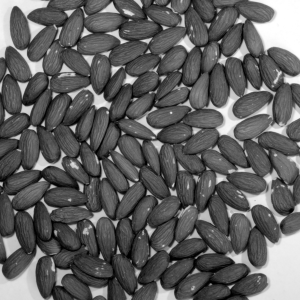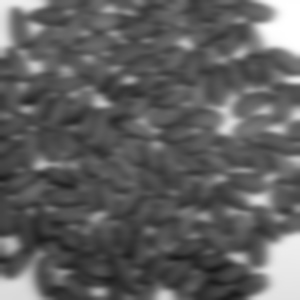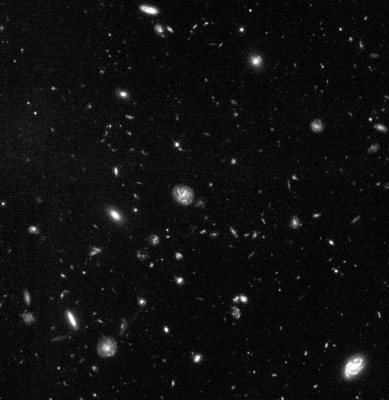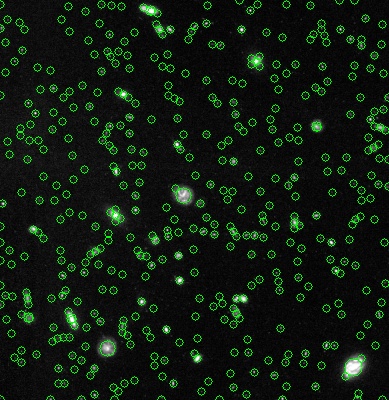This is a C++ implementation of the Laplacian-of-Gaussians method for blob detection. This implementation distinguishes itself from existing implementations, such as in scikit-image or opencv, in two aspects:
- Instead of a sampled Gaussian kernel, it uses the correct discrete analog of the continuous Gaussian from the perspective of scale-space theory. This kernel, which I will refer to as the discrete Gaussian kernel, is based on modified Bessel functions (see here.)
This library provides two C++ functions:
discreteGaussian: Convolves an n-dimensional array with a discrete Gaussian kernel.laplacianOfGaussians: Performs blob detection on an image with the Laplacian-of-Gaussians method, using the discrete Gaussian kernel for the underlying scale-space representation.
This library requires you to have OpenCV installed and linked to your project such that
#include <opencv2/opencv.hpp> works. See
here for the Linux-installation guide
or here for the Windows-installation guide.
Since this is a lightweight header-only library, you can simply copy the include directory
to a location where your project can find it and then use it directly with #include "blobs.hpp".
As an example, your CMakeList.txt could look something like this:
cmake_minimum_required(VERSION 3.22)
project(use_blob_detection)
set(CMAKE_CXX_STANDARD 17)
find_package( OpenCV REQUIRED )
include_directories(${OpenCV_INCLUDE_DIRS})
set(BLOBDETECTION "your/path/blobs_cpp/include]")
add_executable(main main.cpp)
target_link_libraries(main ${OpenCV_LIBS})
target_include_directories(main PRIVATE ${BLOBDETECTION})Example 1: gaussianFilter2d
See also here for the source file.
// First, include some stuff for file-handling.
#include <fstream>
#include <filesystem>
#include <gnuplot-iostream.h>
// We also need to include OpenCV.
#include <opencv2/opencv.hpp>
// Include blob detection.
#include "blobs.hpp"
using namespace cv;
using std::filesystem::current_path;
int main(){
// We test the Gaussian filter on a test image of almonds.
String testImageName = "almonds.png";
// First, we check that the file exists.
ifstream ifile;
ifile.open(testImageName);
// Next, we load the image into an OpenCV matrix.
Mat test_image;
test_image = imread( testImageName, IMREAD_GRAYSCALE);
// The Gaussian filter has two parameters corresponding to the standard deviation of the Gaussian kernel in x1-
// and x2-direction (horizontal and vertical).
double sigma1 = 5.0;
double sigma2 = 2.0;
// We apply the filter by calling the `gaussianFilter2d`-function.
Mat blurred_image = gaussianFilter2d(test_image, sigma1, sigma2);
// Finally, we plot both images with OpenCV.
String nameTest = "Original image";
String nameBlurred = "Filtered image with sigma1 = " + to_string(sigma1) + " and sigma2 = "
+ to_string(sigma2);
namedWindow(nameTest, WINDOW_NORMAL);
namedWindow(nameBlurred, WINDOW_NORMAL);
imshow(nameTest, test_image);
imshow(nameBlurred, blurred_image);
// Press enter to close the windows.
waitKey(0);
destroyWindow(nameTest);
destroyWindow(nameBlurred);
return 0;
}The output should be this:
Example 2: LoG
See also here for the source file.
// Includes as above.
#include <cstdlib>
#include <opencv2/opencv.hpp>
#include <fstream>
#include "blobs.hpp"
using namespace cv;
int main(){
// To test the blob detection method, we use an image of galaxies.
String imageFile = "hubble.jpg";
// Check that the file exists.
ifstream ifile;
ifile.open(imageFile);
// Load the image into an OpenCV matrix.
Mat testImage = imread( imageFile, IMREAD_GRAYSCALE);
// Make the image a bit smaller to speed up the code.
resize(testImage, testImage, Size(), 0.5, 0.5);
testImage.convertTo(testImage, CV_32FC1);
// Normalize for better plotting.
normalize(testImage, testImage, 0, 1, NORM_MINMAX);
// Next we want to apply the Laplacian-of-Gaussians method for blob detection. For this we have to set the
// scales we want to look at.
double sigmaMin {2};
double sigmaMax {20};
int numSigma {19};
// We also have to set the threshold for blob detection and the maximum relative overlap for detected blobs.
// Check the doc-string of the `LoG` function to find out more about those.
double rthresh {0.02};
double maxOverlap {0.2};
// Now we can perform blob detection.
tuple<BlobList, BlobList> blobs = LoG(testImage, sigmaMin, sigmaMax, numSigma, rthresh, maxOverlap);
// The LoG method returns a tuple of two `BlobList`-objects, corresponding to the detected bright and dark blobs.
BlobList brightBlobs = get<0>(blobs);
BlobList darkBlobs = get<1>(blobs);
/* For visualization of the detected blobs, we can use the 'paintBlobs' function provided by 'blobs.hpp'. Since in
* this case we are only interested in the bright blobs, we ignore 'darkBlobs'. If we would be interested in
* plotting both bright and dark blobs, we could call 'paintBlobs' instead with the tuple 'blobs'. */
Mat imageWithBlobs = paintBlobs(testImage, brightBlobs);
// The function 'paintBlobs' returns the test image with the detected blobs drawn on it.
// Let us plot both the original image and the image with the detected blobs.
String nameOrig = "Original image";
String nameBlobs = "Image with blobs";
namedWindow(nameOrig, WINDOW_NORMAL);
namedWindow(nameBlobs, WINDOW_NORMAL);
imshow(nameOrig, testImage);
imshow(nameBlobs, imageWithBlobs);
// Press Enter to close windows.
waitKey(0);
destroyWindow(nameOrig);
destroyWindow(nameBlobs);
return 0;
}The output should be this:
- Additional speedup through downsampling (pyramid).
- Implementation of further blob detection methods (difference of Gaussians, determinant of Hessians, etc.).
- Shape-adaptation: Instead of only identifying circles, detect blobs as rotated ellipses.



